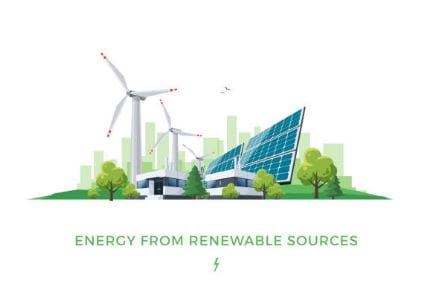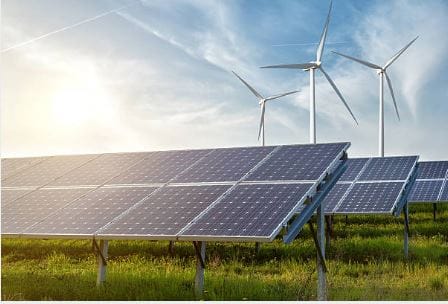Using the term green tech, green technology refers to new innovations which combat environmental damage and decrease carbon pollution while enabling resource sustainability. Green Technology has become the essential foundation of worldwide environmental strategy after the environment deteriorated rapidly because of global carbon emission problems. This piece investigates the present situation of green technology along with its industrial applications and problems it encounters in its path toward establishing a sustainable future.

👉Defining Green Technology: Scope and Objectives :-
Green technology uses knowledge from science engineering and policy to establish solutions that manage environmental issues. Its primary objectives include:
⇒Renewable energy together with energy efficiency allows the reduction of greenhouse gas emissions.
⇒The sustainable management of natural resources happens through practicing circular economy and using sustainable materials.
⇒The preservation of ecosystems becomes possible through pollution management followed by habitat preservation efforts.
Renewable energy together with electric transportation and green building design waste management special materials define the full range of this industry. The worldwide green technology market will cross $1.5 trillion in forecasts for 2025 because of national regulatory requirements together with sustainability initiatives from companies and growing consumer interest.
The different innovations serve as the driving force behind the green tech revolution.
1. Renewable Energy: Beyond Solar and Wind :-
It remains clear that renewable energy systems function as the main foundation of green technology. Both solar photovoltaics (PV) and wind power control the energy landscape during 2025 although technological progress is transforming their operational efficiency and distribution methods:
⏩Ultra Thin Solar Panels :- Flexible lightweight solar modules called ultra-thin solar panels now enable their integration into vehicle bodies and building outer layers and wearable items which extends solar power beyond fixed installations.
⏩Offshore Wind Innovation :- Workers in offshore wind industries have integrated floating wind turbines into deeper water operations to capture stronger wind flows that produce 88 MW of energy sufficient to power 55,000 homes at their Hywind Scotland site.
⏩Bioenergy Breakthroughs :-Bioenergy progresses through the development of waste transformation systems along with algae as a biofuel substance which decreases fossil fuel dependence. The nation of Sweden manages to acquire half of its power requirements through biofuels and waste-based energy systems.
Renewables are projected to take over coal as the dominant electricity source worldwide according to predictions made by the International Energy Agency (IEA) for 2025. These renewable resources will produce 35% of the entire electricity generation.
2. Energy Storage and Smart Grids :-
The periodic nature of renewable energy sources has created obstacles since decades yet the progress in both power storage technologies and power grid adaptability solves these issues effectively.
⏩Solid State Batteries :- The company Quantum Scape along with other businesses focuses on creating solid-state batteries that bring better energy density and enhanced charging speeds suitable for electric vehicle (EV) mass production and grid storage systems.
⏩AI-Optimized Grids :- Artificial intelligence operates within AI-Optimized Grids to conduct dynamic adjustments between power supply and consumption requirements all throughout real-time operations. The Flex Alert system operated in California enables consumers to receive incentives which help decrease peak demand by 10%.
3. Sustainable Transportation :-
The worldwide transportation industry produces 24% of CO₂ emissions so the essential move to decarbonize becomes vital.
⏩Electric Vehicles :- Electric Vehicles (EVs) experience rapid market expansion because battery costs dropped by 89% since 2010. EVs will capture 20% of global car sales in 2025 because of EU and Chinese expansion of charging infrastructure.
⏩Hydrogen Fuel Cells :- Heavy industries together with long-haul transport systems adopt green hydrogen as their fuel. H2Global in Germany plans to establish 5 GW of hydrogen production capabilities by 2030.
⏩Sustainable Aviation Fuel :- The airline companies Delta and United are combining Sustainable Aviation Fuel (SAF) with standard jet fuel to achieve their goal of aviation emission reduction through 10% SAF adoption by 2030.
4. Green Building and Architecture :-
Sustainable change in the construction industry is supported by new innovative design alongside sustainable materials.
⏩Net-Zero Energy Buildings :-New buildings under Net-Zero Energy Buildings (NZEB) standards produce their own power equal to their energy usage. The EU demands that all public buildings built after 2026 must achieve nearly zero-energy buildings status according to their NZEB (Nearly Zero-Energy Building) mandate.
⏩Carbon Neutral Materials :- Cross-laminated timber (CLT) along with recycled steel materials serve as substitutes for concrete which leads to a minimum 40% decrease in building carbon emissions.
⏩Smart Building Systems :- Building systems with IoT sensors reduce both heating ventilation and air conditioning and lighting consumption by 30% in commercial construction.
5. Circular Economy and Waste Management :-
Circular economy practices break away from traditional linear systems to achieve waste reduction through their “take-make-dispose” structures.
⏩Advanced Recycling :- Chemical recycling at Advanced Recycling transforms plastic materials into raw components so they become reusable without limits. The startup venture Agilyx transforms polystyrene waste into styrene monomers which serve as ingredients for new manufacturing materials.
⏩E-Waste Solutions :- Businesses extract rare metals from electronic waste which amounts to 53 million metric tons produced yearly. The Daisy robot from Apple separates 200 iPhones each hour while regaining 95% of its materials.

👉Policy and Economic Drivers :-
Green technology requires government support through policies and financial motivation to reach full scale.
⏩Subsidies & Tax Credits :- Through their respective policies both the US Inflation Reduction Act and the EU Green Deal Industrial Plan support green energy transition with $369 billion tax incentives as well as €250 billion investments.
⏩Carbon Pricing :- Countries worldwide now have more than 40 active carbon pricing programs which create economic advantages for cutting emissions. A carbon price of €100 per ton will become effective throughout 2025 under EU regulations thereby facilitating renewable energy transitions after coal plants.
⏩Regulatory Standards :- The Dual Carbon Policy of China requires peak emissions by 2030 and full carbon neutrality by 2060 which drives investments toward development of wind and solar technologies.
👉Challenges and Limitations :-
Green technology continues to encounter various substantial impediments to its advancement though progress is underway.
⏩High Initial Costs :- Solar farms together with EV factories need considerable initial capital expenditures which prevent smaller businesses from entering. The refurbishment of outdated infrastructure contains high costs to the budget.
⏩Technical Limitations :- Several problems with energy storage technology exist because modern solutions show less reliability than conventional fossil fuels. The lifespan of lithium-ion batteries becomes shorter as they age while the production of hydrogen still demands a considerable amount of energy.
⏩Resource Scarcity :- The production of EV batteries utilizes scarce materials including lithium, cobalt and nickel which exist primarily in the politically sensitive area of the Democratic Republic of Congo. This raises supply chain risks.
⏩E-Waste Management :- The improper disposal of solar panels and batteries leads to the release of dangerous toxic chemicals. The current recycling rate for global e-waste stands at 20% because of environmental pollution problems.
⏩Policy Fragmentation :- The development of global collaboration becomes challenging because different countries implement incompatible regulations. Clean energy markets currently face danger of becoming divided due to green subsidy disagreements between the U.S. and EU.

👉The Road Ahead : Future Trends and Opportunities :-
1. Nuclear Fusion and Advanced Renewables :-
Experts at the French ITER facility work to recreate Earth-based energy systems that mimic solar power production. Scientists predict breakthroughs will lead to commercial clean energy availability by the end of this century although the necessary breakthroughs are still distant.
2. AI and Automation in Sustainability :-
Machine learning optimizes energy consumption as it occurs in real time. DeepMind technology running at Google facilities generated a 40% decrease in cooling expenses through AI-based cooling adjustments.
3. Space-Based Solar Power :-
JAXA plans to deploy solar satellites starting from 2030 to transfer power through microwave transmission as a continuous renewable energy source for Earth.
4. Biodiversity-Positive Technologies :-
The Orca plant of Clime works in Iceland functions as a carbon capture system to extract CO₂ directly from the atmosphere and AI-controlled drones operate for tree planting at 500 trees per hour.
👉How Does Green Technology Impact the Economy?
The economy benefits greatly from green technology through its establishment of sustainable development and cost reductions combined with job generation and innovative advancements. The detailed explanation relies on modern research findings and expert evaluations as follows:
1. Stimulating Economic Growth through Innovation and Efficiency :-
Green technology innovation increases economic development through better resource management systems and reduced enterprise energy usage. The implementation of cleaner production methods with energy-saving technologies reduces operational expenses which helps companies achieve market advantages so they can extend their business operations. Green innovation implementation allows firms to reach higher operational efficiency that produces increased production levels from reduced resource consumption thus enhancing economic output.
The International Monetary Fund (IMF) has demonstrated that countries which double their green patent registrations can expect their GDP to rise by 1.7% during a five-year period according to research findings while more optimistic forecasts indicate even higher economic impacts. The growth in the economy results from technology substitution as well as the complementary innovations that emerge because of green technologies. The new technologies promote additional investments which result in lower production costs together with improved efficiency levels throughout time.
2. Job Creation and Industry Expansion :-
The segments of green technology like renewable energy combined with sustainable manufacturing and environmental consulting demonstrate quick development as industries that generate expanding employment possibilities. Global employment numbers increase significantly due to the expansion of solar energy production and wind energy generation and bioenergy manufacturing as well as electric vehicle manufacturing and green building construction projects. Such growth contributes to economic diversification and strengthens regional resistance against the effects of moving away from fossil fuels.
3. Cost Savings and Increased Competitiveness :-
Businesses together with households save costs by installing both renewable energy systems and energy-efficient technologies. The accumulated savings from these measures enhance business profitability along with disposable income that businesses can redirect to economic growth. Green technology adoption allows companies to build better brand images through their commitment to environmentally conscious consumers and investors thus they secure a stronger market position.
4. The adoption of green technologies helps businesses to minimize economic risks associated with climate change :-
Green technologies reduce economic losses from climate change because they decrease emissions which in turn control global temperature rises. The implementation of green technologies decreases both the number of times and the impact of costly climate-related disasters including floods droughts and storms. The control of these threats leads economies to experience sustained growth without major financial losses.
5. Multiplier Effects and Global Spillovers :-
The implementation of green technologies produces multiple advantages which expand the direct economic improvement. The US Inflation Reduction Act has generated more than $270 billion in clean energy investments that simultaneously lowers domestic emissions as well as stimulates worldwide industries and technologies. Every ton of carbon dioxide reduction in US operations leads to international reductions of 2.4 to 2.9 tons through technology exchanges and global industrial supply networks.
6. Supporting Sustainable Economic Transformation :-
Through green technology economic transformations become sustainable because it advances both energy efficiency and renewable energy systems and circular economy management. The modified economic system enables both sustained development of the economy and decreased environmental impact for continued future progress. Countries can support better industrial development through renewable energy growth which enables them to break their dependence on fossil fuels during economic expansion.
7. Challenges and Policy Importance :-
Adopting green technology faces hurdles due to its high initial expenses as well as limited resources together with regulatory obstacles. Successful green financing methods together with supportive policies provide the key solution to address these problems. Different research studies show that governments must establish regulatory frameworks which both enhance sustainability projects and handle economic constraints during initial transition periods. Sustainability goals receive increased support through international partnerships combined with financial investments that follow sustainable objectives.
In conclusion, Green technology functions as an essential force for economic growth because it generates innovation whereas it produces employment opportunities and cuts expenses and controls climate-related hazards. Strategic policies supported by financial investments will power a sustainable economic advancement which achieves benefits for nature as well as economic progress.

👉How does Green Technology contribute to Reduce the Pollution?
The main pollution mitigation effect of green technology arises from its ability to substitute conventional polluting systems with cleaner sustainable alternatives throughout multiple economic sectors. This detailed review explains how green technology generates pollution reduction:
1. Substituting conventional power sources with renewable power systems forms an essential part of green technology strategy :-
Traditional fossil fuel power plants produce high levels of sulfur dioxide together with nitrogen oxides and particulate matter and greenhouse gases during operation. Green technology enables the use of renewable power sources such as solar power alongside wind power and hydro and geothermal power to create electricity without producing operational emissions. This transition leads to dramatically reduced air contaminations and cuts down carbon dioxide releases which aid climate change mitigation and air quality enhancement.
2. Cleaner Transportation Solutions :-
Urban air pollution originates greatly from transportation operations. Modern electric vehicles operated by renewable energy sources avoid producing tailpipe emissions which decreases hazardous nitrogen oxides as well as particulate matter that triggers smog and respiratory health problems. The use of EVs along with hydrogen fuel cell vehicles minimizes air pollution from conventional engine vehicles most prominently in congested population centers.
3. Advanced Waste Management and Circular Economy :-
Through green technology efforts waste handling receives improvement through programs based on recycling and composting and waste-to-energy systems. New technologies help decrease landfill quantity and produce two benefits: they minimize methane releases while stopping toxic materials from reaching ground and water bodies. Fiscal economy systems manage waste as resources that diminish environmental damage while saving raw materials.
4. Sustainable Agricultural Practices :-
Green technology supports advanced farming methods which minimize both the excessive application of chemical fertilizers and pesticides that contaminate land and water through its precise agricultural functions. Sensor-driven irrigation together with organic farming practices decrease dangerous substance emissions which protect environmental ecosystems and maintain water quality.
5. Pollution Control and Air Quality Monitoring :-
Through carbon capture and storage (CCS) technology industry facilities can extract carbon dioxide emissions from their emissions streams to prevent their release into the atmosphere. Modern technologies employ sensors and artificial intelligence in pollution monitoring to identify and monitor pollution centers which enables fast response to decrease dangerous air pollutants.
6. Lifecycle Pollution Reduction :-
The production and disposal stages of green technologies produce limited environmental impacts although solar panel manufacturing and battery mining activities create certain pollution. However these negative effects remain significantly lower than those produced by conventional fossil fuel technologies. Research methods called Lifecycle assessments let experts identify various pollution sources to develop improvements that lead to overall pollution decreases for green technology throughout its full operational period.
7. Ecosystem Restoration and Climate Mitigation :-
Ecosystem restoration happens through green technology operations of reforestation drones along with sustainable land management to absorb carbon and decrease environmental damage. The production of biofuels along with green hydrogen technology delivers sustainable energy options that help decrease all environmental pollutants and greenhouse gas emissions.
👉Conclusion: A Collective Imperative :-
Green technology has become essential for preserving the planet and its inhabitants and postures itself as a basic requirement for survival. Unprecedented development occurs because policy combines with innovation as well as public awareness alongside the essential solutions of cost and scalability. Predictions indicate that renewables will generate 50% of global electricity by 2030 alongside having EVs control more than half of new car sales by that point.
A achievement of global net-zero emissions needs complete collaboration among governmental bodies and corporate entities and individual sustainable behavior practices. The green tech revolution advances beyond planet-saving to establish a new method of progress which unites nature and humanity.
💬Disclaimer :-
This Blog provides general information as an educational source only. The author uses their life experiences together with personal viewpoints to create all content. The author accepts no responsibility for damages or losses when users apply this information. The website information depends on your individual acceptance of personal risk when you use it. The information does not serve as professional guidance, so readers need to seek proper professional advice before implementing decisions from the provided content.
2 Responses